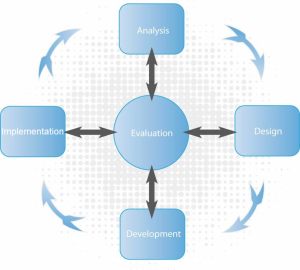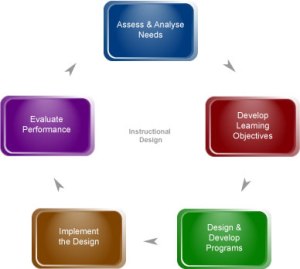1. Definition of Instructional Design (ID). What does an ID do? Include an annotation if any.
The process by which instruction is improved through the analysis of learning needs and systematic development of learning materials. Instructional designers often use technology and multimedia as tools to enhance instruction.
Instructional Design as a Discipline:
Instructional Design is that branch of knowledge concerned with research and theory about instructional strategies and the process for developing and implementing those strategies.
Instructional Design as Reality:
Instructional design can start at any point in the design process. Often a glimmer of an idea is developed to give the core of an instruction situation. By the time the entire process is done the designer looks back and her or him checks to see that all parts of the “science” have been taken into account. Then the entire process is written up as if it occurred in a systematic fashion.
ID makes the acquisition of knowledge and skill more efficient, effective, and appealing.
2. Principles or elements of Instructional Design. Include an annotation if any.
ADDIE – the most common model used for creating instructional materials is the ADDIE Model. This acronym stands for the 5 phases contained in the model (Analyze, Design, Develop, Implement, and Evaluate).
Analyze – The first phase of content development begins with Analysis. Analysis refers to the gathering of information about one’s audience, the tasks to be completed, and the project’s overall goals. The instructional designer then classifies the information to make the content more applicable and successful.
Design – The second phase is the Design phase. In this phase, instructional designers begin to create their project. Information gathered from the analysis phase, in conjunction with the theories and models of instructional design, is meant to explain how the learning will be acquired. For example, the design phase begins with writing a learning objective. Tasks are then identified and broken down to be more manageable for the designer. The final step determines the kind of activities required for the audience in order to meet the goals identified in the Analyze phase.
Develop – The third phase, Development, relates to the creation of the activities being implemented. This stage is where the blueprints in the design phase are assembled.
Implement – After the content is developed, it is then Implemented. This stage allows the instructional designer to test all materials to identify if they are functional and appropriate for the intended audience.
Evaluate – The final phase, Evaluate, ensures the materials achieved the desired goals. The evaluation phase consists of two parts: formative and summative assessment. The ADDIE model is an iterative process of instructional design, meaning at each stage, the designer can assess the project’s elements and revised them if necessary. This process incorporates formative assessment, while the summative assessments contain tests or evaluations created for the content being implemented. This final phase is vital for the instructional design team because it provides data used to alter and enhance the design
3. Give 2 Models of Instructional Design. Include an annotation and a graphic if you find one.
Please look at Part 2 for annotation.
4. What is the difference between Curriculum vs. instruction?
The curriculum is the “what” that is to be taught. Curriculum is designed by state boards of education and education stakeholders; it is influenced by policies, mandates, and legislation.
Instruction is the “how” and the “way” that the curriculum is taught. A teacher can deliver instruction in ways that make it approachable by all students, including those with disabilities, by making it accessible, called differentiated instruction.
5. Explain the difference between theories of instructional design and theories of learning.
The theories of learning:
Behaviourism; There are three basic assumptions that are held to be true. First, learning is manifested by a change in behaviour. Second, the environment shapes behaviour. Third, the principles of contiguity (closeness of the time between two events must be for a bond to be formed) and reinforcement (means of increasing the likelihood of an event to be repeated) are central to explaining the learning process.
There are two types of possible conditioning;
1) Classical conditioning, where the behaviour becomes a reflex response to stimulus.
2) Operant conditioning (Radical Behaviourism), where there is reinforcement of the behaviour by a reward or punishment. A behaviour may result in reinforcement, which increases the likelihood of the behaviour recurring, or punishment, which decreases the likelihood of the behaviour recurring. A punishment is not considered to be applicable if it does not result in the reduction of the behaviour, and so the terms punishment and reinforcement are determined as a result of the actions.
Cognitivism; Cognitive grew out of Gestalt psychology. Gestalt is roughly translated as “configuration” or “pattern” and emphasizes “the whole” of human experience. Gestalt psychologists proposed looking at the patterns rather than isolated events. Two key assumptions underlie this cognitive approach: (1) that the memory system is an active organized processor of information and (2) that prior knowledge plays an important role in learning. Cognitive theories look beyond behaviour to explain brain-based learning. Cognitivists consider how human memory works to promote learning.
Constructivism; Constructivism is a revolution in educational psychology. Constructivism emphasizes the importance of active involvement of learners in constructing knowledge for themselves. Constructivism emphasizes top-down processing: begin with complex problems and teach basic skills while solving these problems. Constructivism explains why students do not learn deeply by listening to a teacher, or reading from a textbook. Learning sciences research is revealing the deeper underlying basis of how knowledge construction works. To design effective environments, one needs a very good understanding of what children know when they come to the classroom.
The theories of instructional design:
ADDIE – Analyze, Design, Develop, Implement, Evaluate.
The difference between the theories is, learning theories focus more on the leaner’s behaviours upon learning, as for theories of instructional design, the main focus are gathering information’s of target audience, the tasks to be completed and project’s overall goals.

